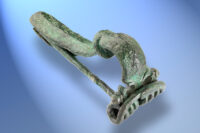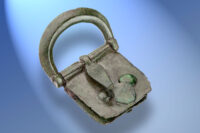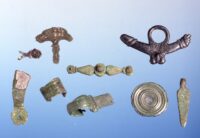 Using a new chemical analysis method, researchers in Germany have identified the metallurgic signature of the Roman 19th Legion in artifacts recovered from the site of the Battle of Teutoburg Forest in Kalkriese, Germany. Mass spectrometer analysis of non-ferrous metals like bronze and brass can pinpoint the characteristic composition of trace elements in an artifact. Because every Roman legion had its own blacksmiths who worked constantly on campaign to repair and replace weapons and equipment, even legions that were fighting together have a distinctive chemical signature in their metals. That this method can be used to conclusively link an object to a specific legion is a major archaeological breakthrough when dating and identifying complex battlefield remains like the ones at Kalkriese.
Using a new chemical analysis method, researchers in Germany have identified the metallurgic signature of the Roman 19th Legion in artifacts recovered from the site of the Battle of Teutoburg Forest in Kalkriese, Germany. Mass spectrometer analysis of non-ferrous metals like bronze and brass can pinpoint the characteristic composition of trace elements in an artifact. Because every Roman legion had its own blacksmiths who worked constantly on campaign to repair and replace weapons and equipment, even legions that were fighting together have a distinctive chemical signature in their metals. That this method can be used to conclusively link an object to a specific legion is a major archaeological breakthrough when dating and identifying complex battlefield remains like the ones at Kalkriese.
In 9 A.D., Publius Quinctilius Varus, appointed two years earlier by Augustus as the first governor of the newly-minted province of Germania, managed to convert a simple troop movement into a history-altering military disaster that was one of the greatest defeats Rome ever suffered. Arminius, a chieftain of the Germanic Cherusci tribe who was also a Roman citizen and aid to Varus, convinced the general there was a rebellion in northern Germany that needed suppressing. The call was coming from inside the house, as it were, and even though Varus was warned not to trust Arminius, he blithely led the 17th, 18th, 19th legions, three cavalry units, six cohorts of auxiliaries and 5,000 or so riding, draft and pack animals, into the most obvious of ambushes: a muddy, narrow, long forest track hemmed in by tree-covered hills. The long, thin snaking line of Roman troops were sitting ducks for the Germanic warriors waiting for them in the woods. When the dust cleared, 15,000 to 20,000 Roman soldiers, including Varus who fell on his sword when he realized he had lost, were dead. Less than 1,000 Romans survived the Battle of Teutoburg Forest, and the defeat resulted in the creation of a hard militarized border in Germany that lasted for 400 years.
This was Augustus first major loss and it haunted him for the rest of his life. His stepson Tiberius and Tiberius’ adopted son Germanicus were able to get back two of the legions’ eagles, including the eagle of the 19th, in revenge expeditions in 15-16 A.D. According to Tacitus (The Annals, Book 1, Chapter 61), they were the first Romans to return to the battlefield and pay their respects to the thousands dead.
There came upon the Caesar [Germanicus], therefore, a passionate desire to pay the last tribute to the fallen and their leader, while the whole army present with him were stirred to pity at thought of their kindred, of their friends, ay! and of the chances of battle and of the lot of mankind. Sending Caecina forward to explore the secret forest passes and to throw bridges and causeways over the flooded marshes and treacherous levels, they pursued their march over the dismal tract, hideous to sight and memory. Varus’ first camp, with its broad sweep and measured spaces for officers and eagles, advertised the labours of three legions: then a half-ruined wall and shallow ditch showed that there the now broken remnant had taken cover. In the plain between were bleaching bones, scattered or in little heaps, as the men had fallen, fleeing or standing fast. Hard by lay splintered spears and limbs of horses, while human skulls were nailed prominently on the tree-trunks. In the neighbouring groves stood the savage altars at which they had slaughtered the tribunes and chief centurions. Survivors of the disaster, who had escaped the battle or their chains, told how here the legates fell, there the eagles were taken, where the first wound was dealt upon Varus, and where he found death by the suicidal stroke of his own unhappy hand. They spoke of the tribunal from which Arminius made his harangue, all the gibbets and torture-pits for the prisoners, and the arrogance with which he insulted the standards and eagles.
And so, six years after the fatal field, a Roman army, present on the ground, buried the bones of the three legions; and no man knew whether he consigned to earth the remains of a stranger or a kinsman, but all thought of all as friends and members of one family, and, with anger rising against the enemy, mourned at once and hated.
 Knowledge of the location of the battlefield was swallowed up by time and forest until 1989 when the suspected site on the Kalkriese Hill in Osnabrück county where Augustan-era coins and lead sling-bullets had been previously found was excavated. Since then, more than 7,000 objects have been unearthed at Kalkriese, from full horse bridle fittings to daily use items to the oldest set of Roman plate armor ever found in Germany. It is unquestionably the site of a major Roman battle from the 1st century, but its identification as the Teutoburg battlefield has taken many decades to confirm and there is still some debate on the subject in the scholarship. It could, for example, have been a battle that took place in Germanicus’ campaign six years later. The archaeological finds cannot be dated within a six year range by any scientific dating method available to us.
Knowledge of the location of the battlefield was swallowed up by time and forest until 1989 when the suspected site on the Kalkriese Hill in Osnabrück county where Augustan-era coins and lead sling-bullets had been previously found was excavated. Since then, more than 7,000 objects have been unearthed at Kalkriese, from full horse bridle fittings to daily use items to the oldest set of Roman plate armor ever found in Germany. It is unquestionably the site of a major Roman battle from the 1st century, but its identification as the Teutoburg battlefield has taken many decades to confirm and there is still some debate on the subject in the scholarship. It could, for example, have been a battle that took place in Germanicus’ campaign six years later. The archaeological finds cannot be dated within a six year range by any scientific dating method available to us.
 Enter the metallurgic signature. The project collected 550 samples from non-ferrous metal objects unearthed at Kalkriese and
Enter the metallurgic signature. The project collected 550 samples from non-ferrous metal objects unearthed at Kalkriese and
The metals used for repairs in the camp forges contain trace elements in such small amounts that they went unnoticed by the Roman forges, nor were they intentionally manipulated. These elements got into the metals through the original ores, the various additives during processing or also through adhesions on the tools. Over time, on-site processing has led the legions to develop a characteristic pattern in the composition of trace elements. “In this way, we can allocate a legion-specific metallurgical fingerprint to the legions, for which we know the camp locations at which they were stationed,” [German Mining Museum Bochum researcher Annika] Diekmann continues. Based on this, all Roman non-ferrous metals from Kalkriese were sampled and compared with non-ferrous metals from numerous Roman locations where it is known from written records which legions were stationed here. […]
After completing the analysis, it is clear that the 19th Legion in particular, which went down with Varus and was stationed in Dangstetten in southern Germany years before, based on the composition of the trace elements stands out from the other legions, which were only deployed later in Germany in the Roman revenge campaigns. “When comparing the finds from Kalkriese with the finds from the other sites, we find that the finds from Dangstetten and Kalkriese show significant similarities. The finds that come from legion sites whose legions did not perish in the Varus Battle, on the other hand, differ significantly from the finds from Kalkriese and thus show significant differences to the finds from Kalkriese.
This should have received way more attention than it did when the press release came out. It’s a pretty big deal. For the longest time, Kalkriese has had its share of doubters and deniers, particularly among the – how to put this politely – “amateur historian” folks and “alternative thinkers” mentality types who tend to be receptive to any kind of conspiracy theory reasoning… you know the kind… But being able to truly identify the presence of one of the legions that went down in the battle absolutely puts the nail in the coffin of any alternative theory of placing the battlefield area in general. (Personally I’ve always felt the on-site bone pits as detailed by Tacitus were a dead giveaway, because they’re so unique and obvious. But who am I…)